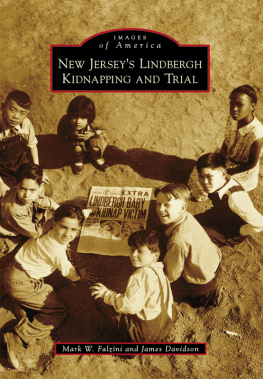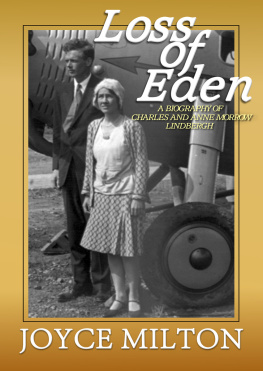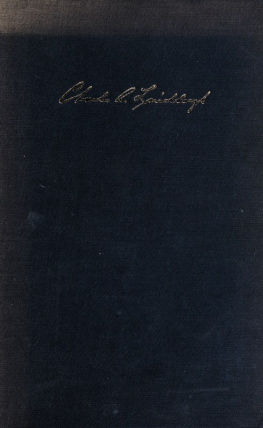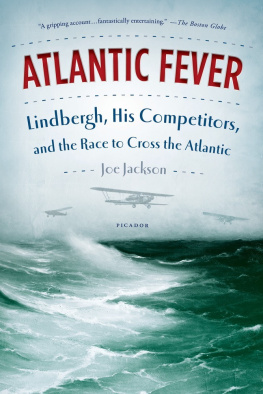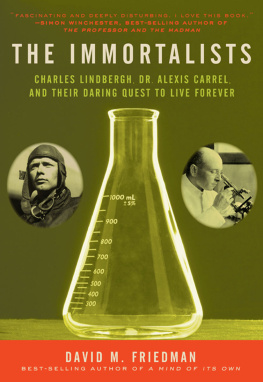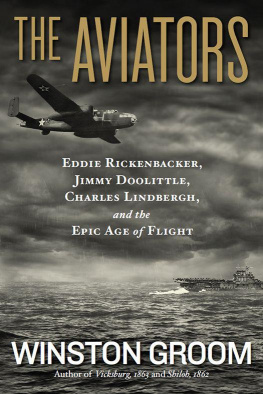Charles Lindbergh - Spirit of St. Louis
Here you can read online Charles Lindbergh - Spirit of St. Louis full text of the book (entire story) in english for free. Download pdf and epub, get meaning, cover and reviews about this ebook. genre: Home and family. Description of the work, (preface) as well as reviews are available. Best literature library LitArk.com created for fans of good reading and offers a wide selection of genres:
Romance novel
Science fiction
Adventure
Detective
Science
History
Home and family
Prose
Art
Politics
Computer
Non-fiction
Religion
Business
Children
Humor
Choose a favorite category and find really read worthwhile books. Enjoy immersion in the world of imagination, feel the emotions of the characters or learn something new for yourself, make an fascinating discovery.
- Book:Spirit of St. Louis
- Author:
- Genre:
- Rating:5 / 5
- Favourites:Add to favourites
- Your mark:
- 100
- 1
- 2
- 3
- 4
- 5
Spirit of St. Louis: summary, description and annotation
We offer to read an annotation, description, summary or preface (depends on what the author of the book "Spirit of St. Louis" wrote himself). If you haven't found the necessary information about the book — write in the comments, we will try to find it.
Spirit of St. Louis — read online for free the complete book (whole text) full work
Below is the text of the book, divided by pages. System saving the place of the last page read, allows you to conveniently read the book "Spirit of St. Louis" online for free, without having to search again every time where you left off. Put a bookmark, and you can go to the page where you finished reading at any time.
Font size:
Interval:
Bookmark:
home@page { margin-bottom: 5.000000pt; margin-top: 5.000000pt; }
The Spirit of Saint Louis
home@page { margin-bottom: 5.000000pt; margin-top: 5.000000pt; }
To A. M. L.
home@page { margin-bottom: 5.000000pt; margin-top: 5.000000pt; }
ACKNOWLEDGMENTS
In working over later drafts of the manuscript for The Spirit of St. Louis, I have used the facilities of several organizations and received assistance from many friends. I wish to express my deep appreciation to the following:
For reading part or all of the manuscript, and for citicism, suggestions, and assistance, which have been of tremendous value: Carl B. Allen; Dana W. Atchley; Betsy Barton; Jeanne A. Blitz; Harold M. Bixby; Kenneth Boedecker; Juno L. Butler; George T. Bye; Eva L. Christie; Michel Detroyat; Hope H. English; Margaret B. Evans; Paul W. Fisher; Judith S. Guild; Harlan A. Gurney; Elisabeth Habsburg; Donald A. Hall; J. G. E. Hopkins; Charles H. Land; Emory Scott Land; Kenneth M. Lane; Anne Morrow Lindbergh; Evangeline Lodge Land Lindbergh; Frank A. Lindbergh; Jon M. Lindbergh; Land M. Lindbergh; Lauren D. Lyman; Constance Morrow Morgan; Esther B. Mueller; Grace Lee Nute; Paul Palmer; Wesley Price; Dorothy E. Ross; Linda L. Seal; H. Robinson Shipherd; John Hall Wheelock.
For refreshing my memory and/or supplying information needed in various chapters: James T. Babb; Gregory J. Brandewiede; Paul E. Garber; Harry F. Guggenheim; John H. Towers; Willard R. Wolfinbarger.
For secretarial assistance: Dorothy M. Austin; Marta A. Brodie; Patricia Carey; Christine L. Gawne; Jeannette Greene; Gladys Leahey; Irene Leahey; Barbara Mansfield; Katharyne. Toner; Anne M. Wylie; Jean W. Wylie.
For research facilities and technical and historical data:
The Institute of the Aeronautical Sciences; The Minnesota Historical Society; The Missouri Historical Society; The National Aeronautic Association; The New York Public Library; The Smithsonian Institution; The Yale University Library.
For newspaper articles, extracts, and information: Aftonbladet, Stockholm; The Associated Press; Chicago Sunday Tribune; The Denver Post; Le Figaro, Paris; and HandelsZeitung, Berlin; International News Service; Los Angeles Times; The New York American; New York Herald Tribune; The New York Times; The New York World; La Prensa, Buenos Aires; St. Louis Globe-Democrat; San Diego Independent; San Diego Sun; San Diego Union; San Francisco Chronicle; The Sunday Star, Washington, D.C. The Times-Picayune, New Orleans; The United Press Associations.
For the use of lines from "The Builders" By Henry Wadsworth Longfellow: Houghton Mifflin & Co.
For hours which might otherwise have belonged to them: Jon, Land, Anne, Scott, and Reeve.
CHARLES A. LINDBERGH
MEMBERS OF
The Spirit of St. Louis
ORGANIZATION
HAROLD M. BIXBY
HARRY F. KNIGHT
HARRY H. KNIGHT
ALBERT BOND LAMBERT
J. D. WOOSTER LAMBERT
CHARLES A. LINDBERGH
E. LANSING RAY
FRANK H. ROBERTSON
WILLIAM B. ROBERTSON
EARL C. THOMPSON

IN GENERAL, this book is about flying, and an aviator's life, in the beginning third of the 20th century. In particular, it describes the planning and execution of the first nonstop airplane flight between the continents of America and Europe. It has been fourteen years in the writing. Started in the city of Paris, during the tense prewar winter of 1938, its manuscript was completed on the shore of Scotts Cove, off Long Island Sound, in the hardly more tranquil year of 1952.
The chapters that follow have been drafted and revised under conditions ranging from the uncertainty of a fighting squadron's tent in the jungles of New Guinea, to the stable family life of a Connecticut suburban home, and under such diverse daily influences as accompany noonday, midnight, and dawn. On top of a manuscript sheet I often marked down my location at the moment of writing or revising. Glancing through old drafts, I now pick out, more or less at random, the following geographical positions: aboard S.S. Aquitania, en route Cherbourg to New York; Army and Navy Club, Washington, D.C.; with the Marines on a Marshall atoll; in a bomber, returning from the North Magnetic Pole; General Partridge's residence at Nagoya, Japan; in a house trailer on the Florida Keys; on an air base in Arabia; parked on a roadside in the Italian Alps; camped in Germany's Taunus mountains; at the Carrels' island of St. Gildas.
Because the writing began more then eleven years after the last incident described took place, and because detailed records were not available at the time and later could not be transported everywhere the manuscript traveled, I have drawn heavily on memory for early drafts.
Searching memory might be compared to throwing the beam of a strong light, from your hilltop camp site, back over the road you traveled by day. Only a few of the objects you passed are clearly illuminated; countless others are hidden behind them, screened from the rays. There is bound to be some vagueness and distortion in the distance. But memory has advantages that compensate for its failings. By eliminating detail, it clarifies the picture as a whole. Like an artist's brush, it finds higher value in life's essence than in its photographic intricacy.
Records, on the other hand, illuminate the corners with which they are concerned, and surround your mind with their contemporary problems. They are relatively specialized, sometimes contradictory, and often incomplete. They restrict your perspective by bringing you too close to the area they cover. But they offer pay in precision for what they lack in breadth. I have rearranged and rewritten later manuscript drafts under the light of documents culled from attics, files, and libraries.
Throughout the following chapters I have digested conversations and press articles in order to avoid tedious detail. In telegrams I have used the originals where they were available, and approximated from memory where they were not. Since it is impossible to describe exactly the wanderings of the mind, I have placed flashbacks out of sequence to attain impressionistic truth. All incidents in this book are factual, and I have tried to put them into words with accuracy. The engine log and navigation log of the Spirit of St. Louis were stolen by some member of the crowd that overran fences and guards at Le Bourget. Therefore the log entries which form chapter heads in Part II have been filled in from performance curves and other records. The figures used are close to those marked down in flight, but there is certainly some variation.
When the Spirit of St. Louis flew to Paris, aviation was shouldering its way from the stage of invention onto the stage of usefulness. Enthusiasts still talked about "the conquest of the air." Rules for safety were sometimes just the reverse of today's. When a pilot encountered fog, he turned his eyes to the earth instead of to his dials, and the quality of
his senses was as important as that of his mind. The ability of an aircraft to make an emergency landing in a small pasture warranted a considerable reduction in its cruising speed; while the advantage of a cockpit forward, from the standpoint of vision, was more than offset by the advantage of a cockpit aft, from the standpoint of crash. But the monoplane had become a serious threat to the biplane's superiority. Instrument-flying techniques were being developed by the more progressive pilots. And promises of radio communication gave airmen cause for hope.
Along with most of my fellow fliers, I believed that aviation had a brilliant future. But my vision, extravagant as it seemed at the time, fell short of accomplishments now achieved with aircraft, by their pilots, engineers, and executives. Speeds, ranges, altitudes, powers, sizes, economies, and destructive capabilities today have shattered limiting factors of a quarter century ago. Science has transformed the frail craft of Le Bris, Lilienthal, and the Wright brothers into metal, and loaded them with cargoes varying from orchids to atomic bombs. Thousands of men, women, and children now cruise each day above the racing pilot's speed of 1927. Agencies all over the world sell tickets to cross the ocean at steamer-travel prices. Airlines have flown billions of passenger miles between fatalities. Engines have changed their horsepower ratings from hundreds into thousands. Military crews fly regularly above what the world's altitude record used to be.
Font size:
Interval:
Bookmark:
Similar books «Spirit of St. Louis»
Look at similar books to Spirit of St. Louis. We have selected literature similar in name and meaning in the hope of providing readers with more options to find new, interesting, not yet read works.
Discussion, reviews of the book Spirit of St. Louis and just readers' own opinions. Leave your comments, write what you think about the work, its meaning or the main characters. Specify what exactly you liked and what you didn't like, and why you think so.


